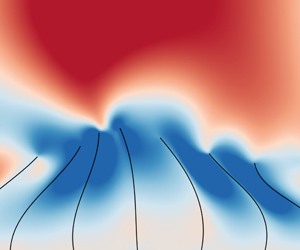Article contents
The mechanics of cilium beating: quantifying the relationship between metachronal wavelength and fluid flow rate
Published online by Cambridge University Press: 23 March 2020
Abstract

We investigate the relationship between the metachronal wavelength of an array of beating cilia and the resulting fluid flow rate through numerical simulations. Our model is based on a hybrid immersed boundary lattice Boltzmann algorithm. Our results suggest that varying the metachronal wavelength of the cilium array affects the fluid flow rate by increasing or decreasing the spread of cilia during their active strokes. We quantify this behaviour by constructing an analytical model of the system and deriving an equation for free area within the cilium array that depends on the metachronal wavelength. We show that there is a strong correlation between free area and fluid flow rate that holds for different values of cilium spacing.
- Type
- JFM Papers
- Information
- Copyright
- © The Author(s), 2020. Published by Cambridge University Press
References
- 8
- Cited by




